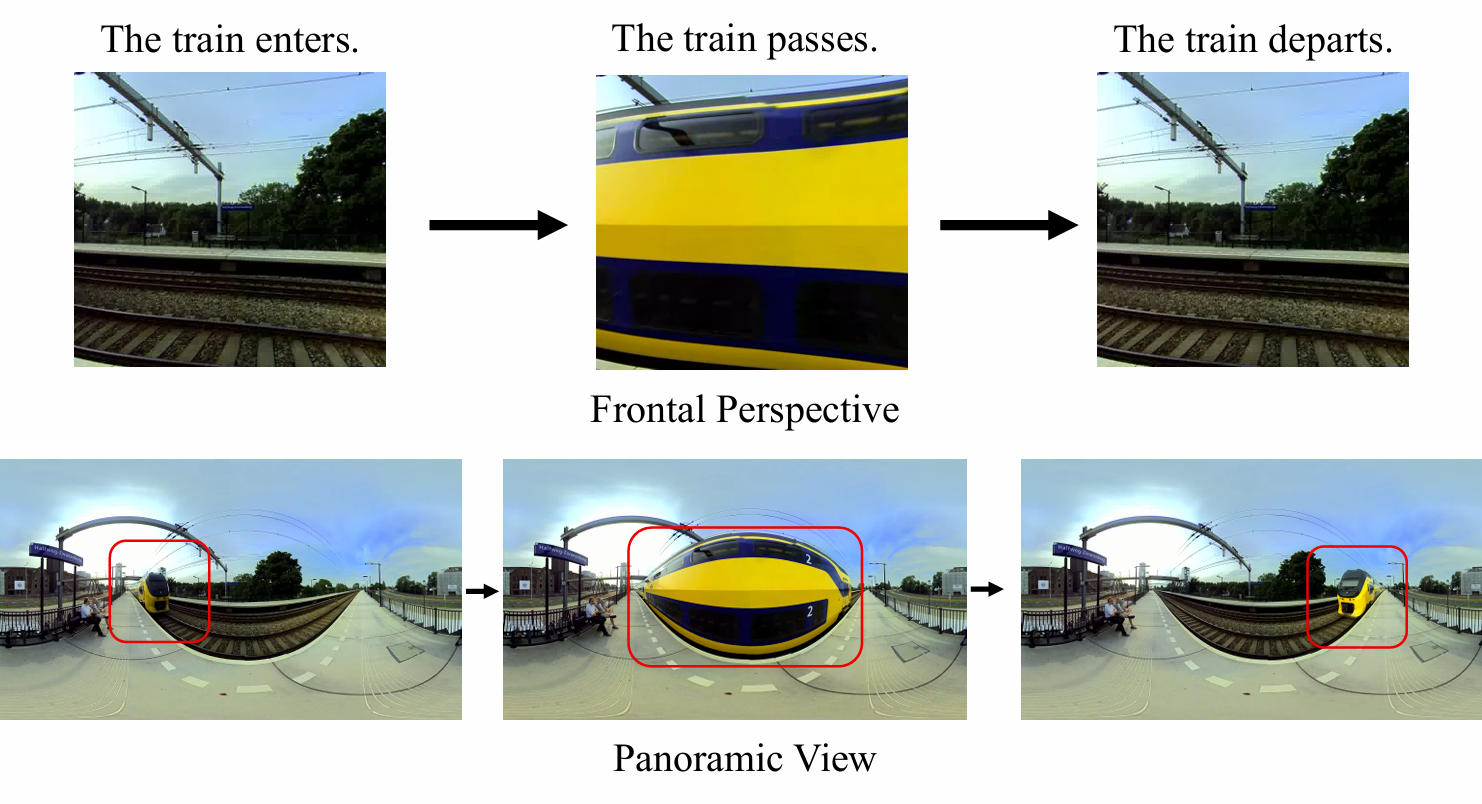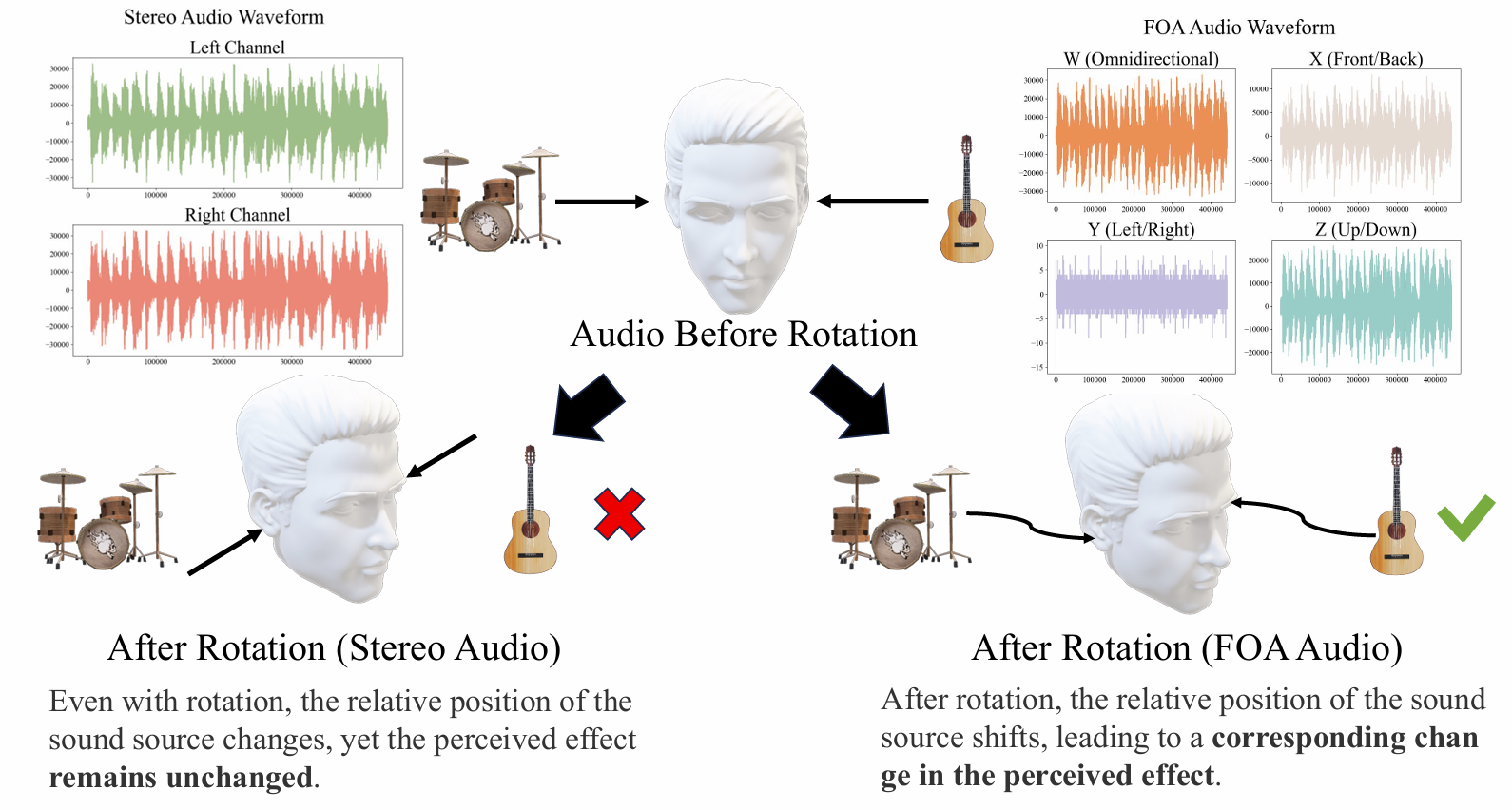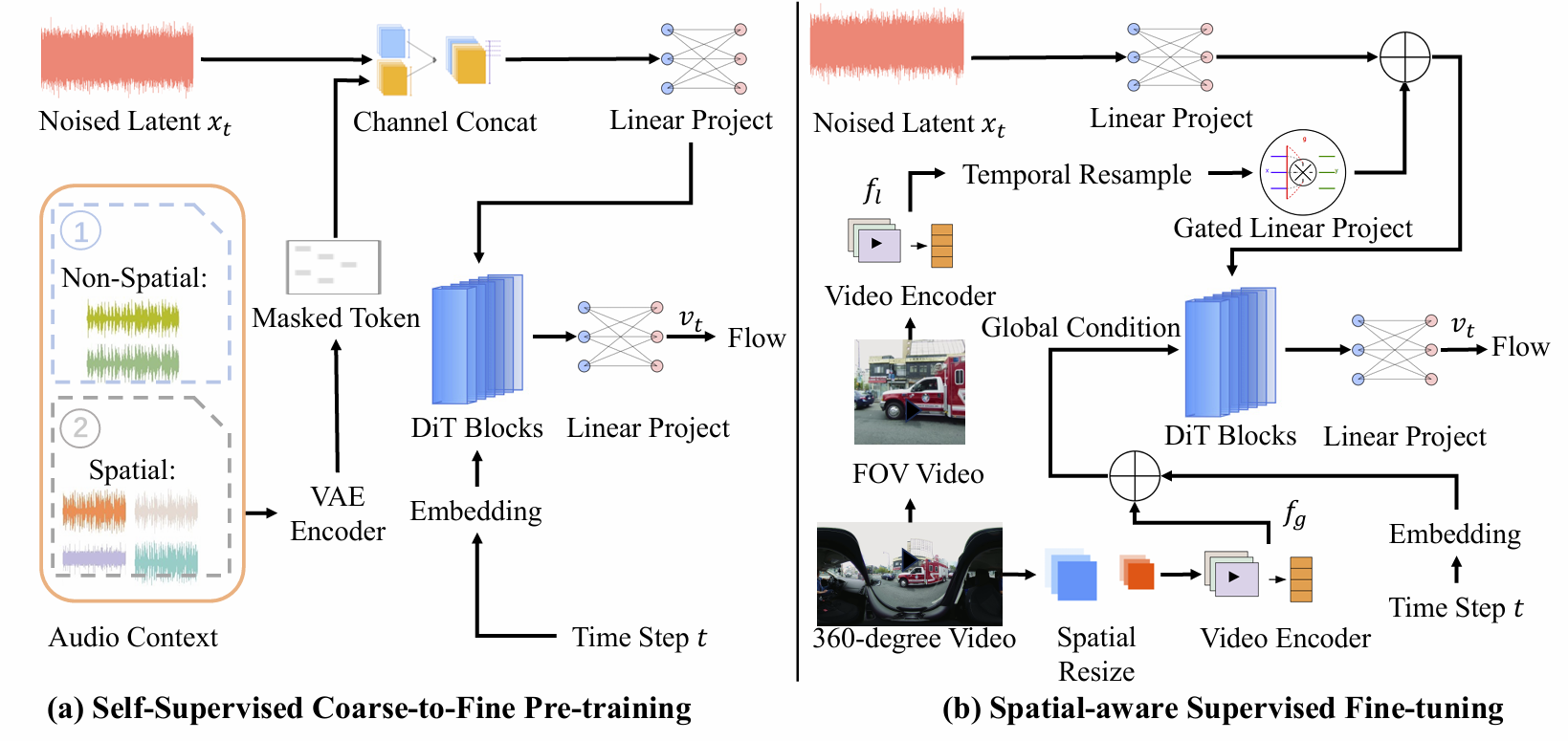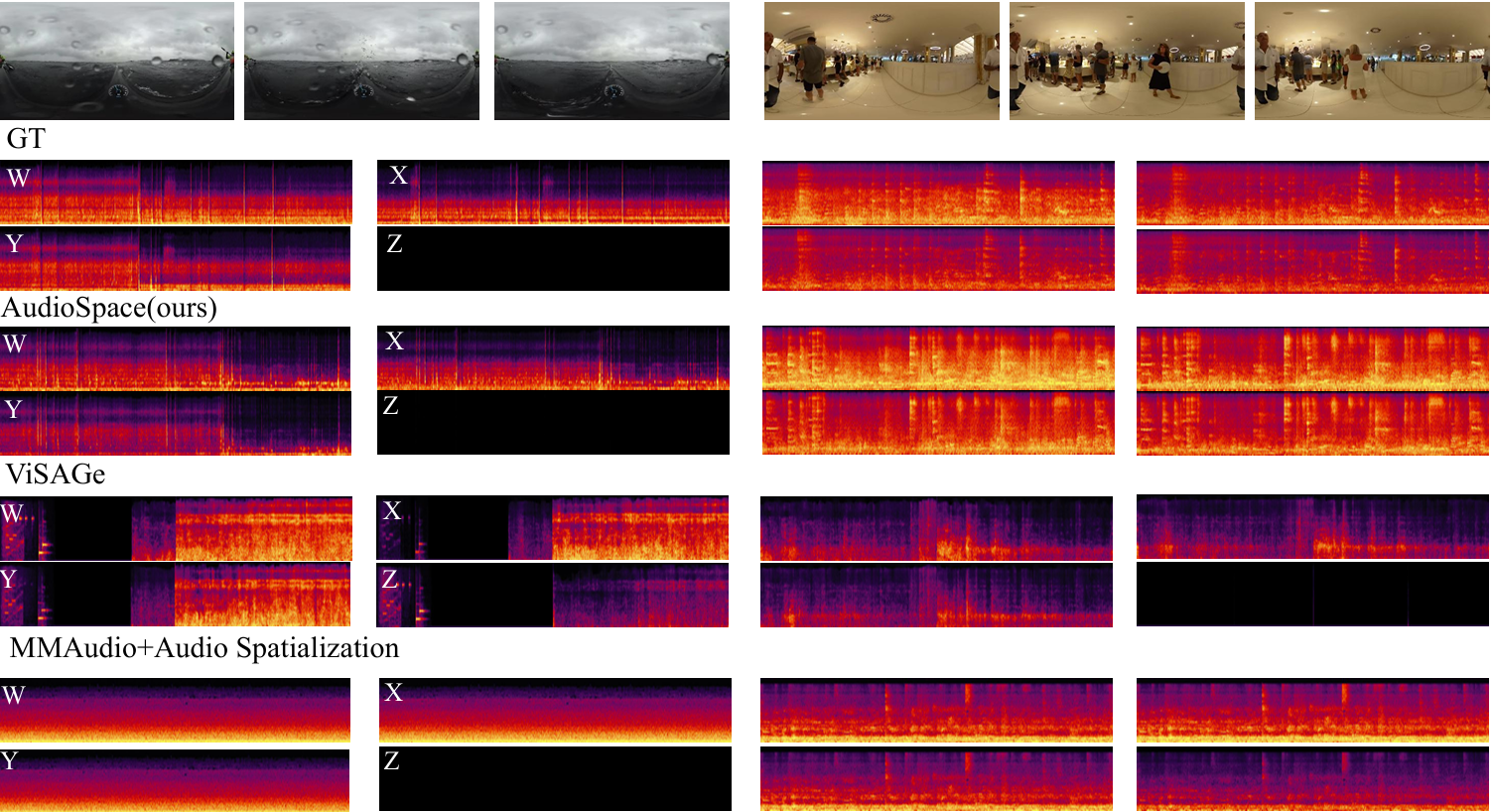 arXiv
arXiv
 Code
Code
 Dataset
Dataset
Traditional video-to-audio generation techniques primarily focus on field-of-view (FoV) video and non-spatial audio, often missing the spatial cues necessary for accurately representing sound sources in 3D environments. To address this limitation, we introduce a novel task, 360V2SA, to generate spatial audio from 360-degree videos, specifically producing First-order Ambisonics (FOA) audio - a standard format for representing 3D spatial audio that captures sound directionality and enables realistic 3D audio reproduction. We first create Sphere360, a novel dataset tailored for this task that is curated from real-world data. We also design an efficient semi-automated pipeline for collecting and cleaning paired video-audio data. To generate spatial audio from 360-degree video, we propose a novel framework OmniAudio, which leverages self-supervised pre-training using both spatial audio data (in FOA format) and large-scale non-spatial data. Furthermore, OmniAudio features a dual-branch framework that utilizes both panoramic and FoV video inputs to capture comprehensive local and global information from 360-degree videos. Experimental results demonstrate that OmniAudio achieves state-of-the-art performance across both objective and subjective metrics on Sphere360.
The rapid advancement of virtual reality and immersive technologies has significantly amplified the demand for realistic audio-visual experiences. However, current video-to-audio methods typically generate non-spatial (mono or stereo) audio, which lacks essential directional information, and rely on limited perspective videos that miss crucial visual context. As illustrated in Figure 1-a, panoramic videos capture a complete 360-degree view, enabling the simultaneous observation of all sound sources—such as a moving train—that remain invisible in frontal perspectives. Additionally, Figure 1-b shows that stereo audio fails to maintain sound localization during head rotations, whereas spatial audio in First-order Ambisonics (FOA) retains accurate positioning. To address these limitations, we introduce 360V2SA, a novel task that generates FOA spatial audio directly from 360-degree videos, leveraging comprehensive visual information to enhance audio realism and immersion.


As illustrated in Figure 2 , OmniAudio consists of two main stages: (1) we employ a coarse-to-fine self-supervised flow matching pre-training (Figure 2a) to alleviate the issue of data scarcity using both unlabeled spatial and non-spatial audio. (2) In the fine-tuning stage (Figure 2b), we perform spatial-aware supervised fine-tuning by utilizing a dual-branch video representation combined with a flow matching objective.

The following presents a comparison between the ground truth (GT), the results generated by OmniAudio, and two baseline methods: a cascaded system that integrates the state-of-the-art video-to-audio generation model MMAudio (a FoV Video + Text to Monophonic Audio model) along with an audio spatialization component (AS, which uses GT angle rendering for spatialization), and ViSAGe, a recent model designed for generating spatial audio from perspective video inputs, producing 5-second audio segments. Details of the spatialization component can be found in the appendix. Each video provides a different perspective on the 360-degree audio experience. The video ID format is "youtube id _ start time(s)", with each video segment lasting 10 seconds. FOA audio from these videos is decoded into binaural audio using Omnitone. Once again, please make sure to wear headphones 🎧 and drag the screen to fully experience the 360-degree audio 🎥.
This section presents the comparison of generation results for the models listed in Tables 3 and 4 of the paper.
| Model | Dataset | FD↓ | KL↓ | Δabsθ↓ | Δabsφ↓ | ΔAngular↓ | MOS-SQ↑ | MOS-AF↑ |
|---|---|---|---|---|---|---|---|---|
| GT | YT360-Test | / | / | / | / | / | 85.38±0.95 | 87.85±1.21 |
| Diff-Foley + AS | YT360-Test | 361.65 | 2.22 | / | / | / | 67.21±0.95 | 70.34±1.76 |
| MMAudio + AS | YT360-Test | 190.40 | 1.71 | / | / | / | 73.25±1.05 | 76.77±1.23 |
| ViSAGe (FOV) | YT360-Test | 199.09 | 1.86 | 2.21 | 0.88 | 1.99 | 71.82±1.98 | 72.17±1.47 |
| ViSAGe (360) | YT360-Test | 225.52 | 1.95 | 2.18 | 0.86 | 1.98 | 72.45±1.64 | 72.96±1.39 |
| OmniAudio | YT360-Test | 92.57 | 1.64 | 1.27 | 0.53 | 1.27 | 80.37±0.91 | 83.49±1.01 |
| GT | Sphere360-Bench | / | / | / | / | / | 88.41±0.79 | 90.12±1.08 |
| Diff-Foley + AS | Sphere360-Bench | 331.05 | 3.56 | / | / | / | 69.87±0.84 | 71.12±1.36 |
| MMAudio + AS | Sphere360-Bench | 271.15 | 2.39 | / | / | / | 75.34±0.99 | 77.56±1.22 |
| ViSAGe (FOV) | Sphere360-Bench | 210.87 | 2.90 | 1.51 | 0.71 | 1.49 | 73.45±1.42 | 74.89±1.71 |
| ViSAGe (360) | Sphere360-Bench | 219.66 | 2.96 | 1.52 | 0.74 | 1.51 | 74.12±1.18 | 75.34±1.03 |
| OmniAudio | Sphere360-Bench | 88.30 | 1.58 | 1.36 | 0.52 | 1.28 | 84.67±1.06 | 87.23±0.98 |
| Model | FD↓ | KL↓ | Δabsθ↓ | Δabsφ↓ | ΔAngular↓ |
|---|---|---|---|---|---|
| coarse-to-fine | 88.30 | 1.58 | 1.36 | 0.52 | 1.28 |
| w/ fine | 97.57 | 1.82 | 1.36 | 0.57 | 1.28 |
| w/ coarse | 97.26 | 1.78 | 1.36 | 0.66 | 1.30 |
| w/o PT | 104.57 | 1.83 | 1.39 | 0.58 | 1.32 |
| Model | FD↓ | KL↓ | Δabsθ↓ | Δabsφ↓ | ΔAngular↓ |
|---|---|---|---|---|---|
| ERP+FOV | 88.30 | 1.58 | 1.36 | 0.52 | 1.28 |
| EAC+FOV | 89.89 | 1.66 | 1.33 | 0.55 | 1.29 |
| w/ FOV only | 88.80 | 1.87 | 1.41 | 0.59 | 1.33 |
| w/ EAC only | 93.37 | 1.84 | 1.37 | 0.57 | 1.30 |
| w/ ERP only | 97.83 | 1.87 | 1.35 | 0.59 | 1.28 |




We would like to thank Omnitone for the 360° Interactive Video Demo Player.
@misc{liu2025omniaudiogeneratingspatialaudio,
title={OmniAudio: Generating Spatial Audio from 360-Degree Video},
author={Huadai Liu and Tianyi Luo and Qikai Jiang and Kaicheng Luo and Peiwen Sun and Jialei Wan and Rongjie Huang and Qian Chen and Wen Wang and Xiangtai Li and Shiliang Zhang and Zhijie Yan and Zhou Zhao and Wei Xue},
year={2025},
eprint={2504.14906},
archivePrefix={arXiv},
primaryClass={eess.AS},
url={https://arxiv.org/abs/2504.14906},
}